
As a result of climate change, 150 million people will need humanitarian aid in 2030, 50 million more than today; 258 million boys and girls are still not receiving an adequate education; at the end of 2021, 435 million girls and women worldwide will be below the poverty line. The year 2021 thus confirms the negative trend of 2020. The progress made in recent years towards achieving the 2030 Agenda Goals has come to a standstill with the arrival of Covid-19.
These are the main findings of the 2021 edition of the WeWorld Index, the ranking on the level of inclusion of women and children in 172 countries, which photographs the post-pandemic world by analysing the situation of women and children in relation to 34 indicators (environmental, social, educational, economic and health-related). The 7th edition of the WeWorld Index was presented today by WeWorld - an Italian organisation that has been defending the rights of women and children in the world for 50 years in 25 countries including Italy - in an online event attended by the WeWorld President Marco Chiesara; Elena Caneva, WeWorld Study Centre Coordinator; Ambassador Maurizio Massari, Permanent Representative of Italy to the United Nations; Marina Sereni, Vice-Minister for Foreign Affairs and International Cooperation; Yasmin Sherif and Marco Grazia from the Global Fund for Education in Emergency Contexts "Education Cannot Wait"; Lia Romano, Emergency Program Coordinator, Meg Gardinier, Secretary General of ChildFund Alliance.
The report insists on the need to move from the mere promotion of women's and children's rights to their implementation, taking into account the effects of climate change on their lives and well-being. Climate change is in fact the focus of the WeWorld Index 2021.
The countries at the top (Iceland, New Zealand, Sweden, Switzerland and Finland) and at the bottom (Central African Republic, South Sudan and Chad) of the ranking do not change radically with respect to 2020, but the main data tells us that 2021 opens a new decade of poverty and inequality, a negative trend that began in 2020. The progress made in recent years, more or less decisively from country to country, towards achieving the goals of the 2030 Agenda has suffered a decisive and transversal setback with the arrival of Covid-19. The social groups that have suffered most are those who were already living in conditions of marginalisation and discrimination before the pandemic, and among these are women and children, with 150 million people at humanitarian risk by 2030 due to climate change, 435 million girls and women below the poverty line and child labour that could increase by 8.9 million by the end of 2022.
The 2021 report includes insights into Brazil and Mozambique, two countries that are representative of the effects of the pandemic: in Brazil, the pandemic – combined with the actions of a government that did not take care of the vulnerable sections of the population – dragged the country down to 92nd place in the ranking, compared to 54th place in 2015. In Mozambique, the inclusion of women and children has improved markedly, but the pandemic and Cyclone Idai have slowed the country's progress from 145th place in 2015 to 140th today – a growth that would have been more evident without the effects of the cyclone.
"Brazil and Mozambique are a good example of how, if we do not work on all fronts at the same time, progress can be lost very rapidly". Says Marco Chiesara, WeWorld President “If we do not work holistically, a single critical event - such as the passage of a cyclone - is enough for the efforts made to be thwarted and for all rights, from education to health, to be set back. Moreover, if we do not act globally with policies and interventions that make even the most fragile countries grow, the process of acquiring, enjoying rights and accessing services can only be partial and temporary, excluding the poorest countries. But for change to be real, interventions must focus on a gender and generational approach so that growth is not only the preserve of those who already enjoy greater resources. A case in point is Brazil (and the BRICS countries), which has experienced very strong economic growth that has not been accompanied by social interventions aimed at the fringes most at risk of exclusion from the population”.
Highlights
- Compared to 2020, there are no major changes in the top positions: the most inclusive countries, for women and children, remain basically the same (North Europe, plus New Zealand and Switzerland), with a few slight changes in the position of some. In particular, Norway gets worse (from the first position in 2020 to the sixth in 2021) and Finland too (from the second to the fifth); Switzerland (from the seventh to the fourth) and New Zealand on the other hand (from the fifth to the second) improve.
- The first three positions in the ranking are occupied by Iceland, New Zealand and Sweden. Switzerland and Finland are right behind them. This confirms the supremacy of Northern European countries, plus New Zealand. In the last positions we find the same countries of 2020: Central African Republic (170th position), South Sudan (171st) and Chad (172nd). In these countries, the situation of women and children is still critical in all the dimensions considered in the Index.
- In 2020, in women's and children's rights and inclusion there had been a worsening due to the pandemic worldwide; 2021 confirms this negative trend.
- In 2020, more than 50 million people were doubly affected: by climate change disasters and the Covid-19 pandemic.
- In 2020, there were 26.4 million refugees worldwide. 39% of them are hosted in only 5 countries: Turkey, Colombia, Pakistan, Uganda and Germany. There are 40.5 million new IDPs, the highest number ever in the last ten years.
- Before the outbreak of the pandemic, progress towards inclusive and equitable education for all was proceeding too slowly, with the prospect of having 200 million children still out-of-school in 2030. Nowadays about 258 million children are out of school: 59 million out of primary, 62 million out of lower secondary and138 million out of upper secondary. More than half of them live in Sub-Saharan Africa.
- The employment crisis and school closures have forced low-income families to fall back on child labour or forced marriages as a coping mechanism. Due to Covid-19, child labour could increase by 8.9 million cases by the end of 2022, and more than half of these would involve children between 5 and 11 years old.
Focus: the impact of climate change on women's and children's rights
Climate change does not affect everyone in the same way: the most marginalised communities, for social, cultural and/or economic reasons, are at the greatest risk. Among the most tangible consequences on people's lives are poverty, food and water shortages, migration, conflict and violence. Areas already affected by chronic poverty, such as coastal areas in South Asia, desert regions in sub-Saharan Africa, but also small island developing states are particularly vulnerable to the adverse impacts of climate change.The impact of climate change is disproportionally distributed over those populations that contribute least to the problem. Just think that the top six emitters of greenhouse gases are, in order: China, the United States, the European Union (including the United Kingdom), India, Russia and Japan. This shows how climate change exacerbates social inequalities: triggered mainly by high-income countries, it will have catastrophic effects on low-income countries in particular. The most vulnerable sections of the population, such as women, children and adolescents, will suffer the most.
The effects on children: Children are the category most at risk: almost 2 billion of them live in areas where every year air pollution levels exceed the standards fixed by the World Health Organization; 1 child out of 4 dies before 5 due to unhealthy environments.
The effects on women: the negative effects of climate change amplify pre-existing gender inequalities and exacerbate the marginalisation and discrimination of women and girls in affected communities. When a significant change in climate conditions damages the natural resources needed to earn a living, women cannot support themselves and their families. As a result, they are often forced to resort to environmentally unsustainable practices. This exposes them to serious health risks and feeds the vicious cycle of climate change inducing practices. Women are also less able to move and escape the effects of natural disasters. Highly stressful conditions, economic hardship and violence put displaced girls at serious risk of forced marriage, becoming victims of labour and/or sexual exploitation and dropping out of school.
Focus on Italy
In Italy the price of the pandemic was paid most by women and children. Italy was the country with the highest number of days of school closures in Europe; in addition, the economic condition of women has deteriorated.



